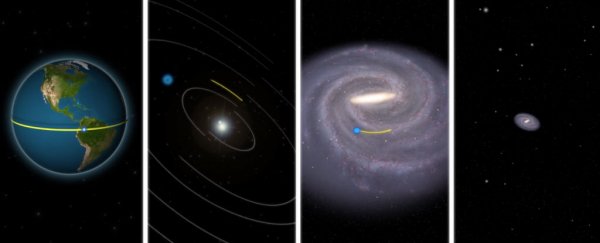It's one of the most fundamental contradictions of life on Earth - we're sitting on a planet that's spinning on its own axis as it zooms around the Solar System, and that Solar System is zooming around a galaxy that itself is zooming around the Universe, and here we all are, sitting down feeling like we're not even moving at all.
The reality is that by the time you watch the 2-minute video above, you'll have travelled more than 100,000 km (64,000 miles) through the Universe at a speed of over 3 million km/h (1.9 mph). That's around 850 km per second, or 530 mps.
How do scientists even know that? It's actually a lot trickier than you think, as the video from Business Insider explains, because speed is not absolute - it's relative. So if you want to figure out the speed of something, whether it's an atom, your car, or the Milky Way galaxy, you need to know the speed of something else to measure it against.
In other words, if you're sitting still reading this, you're not moving any distance at all if you measure your speed relative to the chair you're sitting in. Similarly, when we say a car is travelling at a speed of 100 km/h (62 mph), that speed has been calculated based on a fixed spot on Earth's surface.
But, as we all know, in reality, there is no fixed spot on the surface of the planet. At its fastest point - the equator - Earth is spinning on its axis at speeds of about 1,675 kilometres per hour (1,040 mph). So what if you measured your speed on Earth relative to the rest of the Universe?
To calculate that, we first have to figure out how fast the planet we're living on is moving around. While it's spinning at 1,675 km/h, it's also orbiting the Sun, and we can measure how fast by looking at how long one of those rotations takes - 365.24 days. As the video explains, that whole journey is about 940 million km (584 million miles), which means Earth is travelling around the Sun at speeds of around 107,290 km/h (66,667 mph). Mind-blowing, right?
But the Solar System isn't a stationary object in the Milky Way galaxy, and the Milky Way galaxy isn't a stationary object in the Universe. So what if you added those speeds into the equation too?
Well, the Sun and all the planets in the Solar System are spinning around the centre of the Milky Way, while at the same time moving upwards relative to the Milky Way plane, and when you take all of that into consideration, we're moving around the galaxy at about 871,781 km/h, or 541,700 mph. And that's not even counting the fact that our Milky Way is also zooming through the Universe.
I'll let the Business Insider video above explain how fast our own galaxy is moving, and how scientists can actually figure that out, but why can't we feel any of this? If we're really travelling 850 km per second - or 530 mps - around the Universe, why don't all of us have the most almighty case of inertia? We can thank the consistency of its spin for that.
It's hard to really comprehend the fact that you're sitting on a planet that's zooming around a massive Solar System that's zooming around an even more massive galaxy that's hurtling through an unfathomably large Universe, but if you feel like you've accomplished nothing today, remember that by the time you've finished reading this, you'll have travelled 100,000 km through space without even breaking a sweat. How lucky are we?
